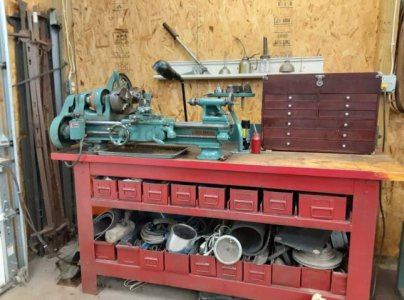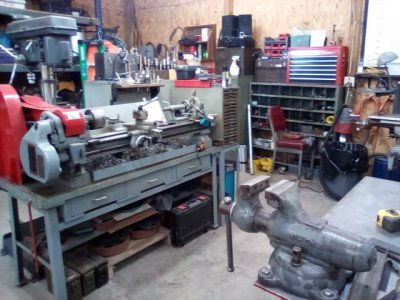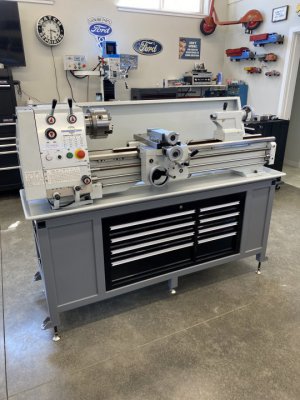-
Welcome back Guest! Did you know you can mentor other members here at H-M? If not, please check out our Relaunch of Hobby Machinist Mentoring Program!
You are using an out of date browser. It may not display this or other websites correctly.
You should upgrade or use an alternative browser.
You should upgrade or use an alternative browser.
Lathe Bench and Tool storage
- Thread starter madmatt41
- Start date
- Joined
- Oct 16, 2019
- Messages
- 6,579
I have a setup similar to @Batmanacw only my stand has a drawer where the top shelf is on his. Underneath that are two Kennedy boxes on a fixed shelf. I have some 100# capacity drawer slides that I'll use to make a sliding shelf for them. Someday...
- Joined
- Jul 29, 2014
- Messages
- 2,737
I have never had any kind of rust problem in the summer, but in winter some rust can appear very quickly…this happens to only some pieces, but kind of hard to predict which. I have tried most of the known rust preventive sprays, but I’m not impressed. I get the best results with Johnson’s paste wax. Notably, I’ve never had a rust problem with any QCTP parts, tailstock chucks, etc., and these are in contact with wood, to a minor extent. The wood has been treated with Tung Oil, maybe that helps…maybe as does living in California, not Navada.I notice your tailstock chucks stored on what appears to be a wood shelf drilled to size. Is this correct? I tried this a few years back and seemed the wood drawed the humidity from the room in the summer and started to rust the MT shafts where they were in contact with the wood. If you have this problem how did you solve?
- Joined
- Jul 10, 2013
- Messages
- 1,190
My bench lathe is now setting its third bench. Well, the first one really does not count. I had to have something to place my new toy on. After building and using the second bench, there were three main things became important for me that a bench must have. The bench is built rigid so that there is no racking and twisting. On top of the thick 1 1/2" wood tabletop, there is a 1/4" thick steel channel that acts as a strongback. On top of the strongback are risers that support the feet of the lathe. That gave me more clearance under the lathe and access to all four motor mounting bolts without having to raise the lathe.
The second is mounting a power panel above the tail end. This has a main switch that supplies power to good lighting above the lathe. It has three plugins that are easy access including the lathe plug.
Third: I built a set of drawers and shelves in the bench. It's really nice to have the tooling with the lathe.
One added thing is that because of limited space the bench is mounted on casters. On the tailstock end the casters are mounted on a beam that pivots in the middle. By doing this, the lathe is mounted on a rigid three-point plane, just like a lathe on a navy ship.
The second is mounting a power panel above the tail end. This has a main switch that supplies power to good lighting above the lathe. It has three plugins that are easy access including the lathe plug.
Third: I built a set of drawers and shelves in the bench. It's really nice to have the tooling with the lathe.
One added thing is that because of limited space the bench is mounted on casters. On the tailstock end the casters are mounted on a beam that pivots in the middle. By doing this, the lathe is mounted on a rigid three-point plane, just like a lathe on a navy ship.
- Joined
- Mar 3, 2017
- Messages
- 747
I notice your tailstock chucks stored on what appears to be a wood shelf drilled to size. Is this correct? I tried this a few years back and seemed the wood drawed the humidity from the room in the summer and started to rust the MT shafts where they were in contact with the wood.
Wood wicks water, true; it also wicks oils. Paint (or wipe) the woodwork with something like boiled linseed oil, and
its surfaces will become hydrophobic. A bit of heavy use doesn't scrape the BLO finish off, because
it's a kind of penetrating stain. The wood does have to be dry at oil-application-time, for good results.
Oh, and the odor of freshly applied BLO is annoying; warm weather and ventilation will be best for doing that chore.
It's suitable for bringing into the house after a few days.
I ran a manufacturing business and use the same system now that I'm a hobbyist. Frequently used tools (chuck keys, tool holders, wrenches, scratch pad, files, lubes, file card, etc.) within arms reach. Measuring tools sit on top of the head stock while in using the lathe but get put away in drawers every night. One of my chucks is heavy enough that I keep it on a shelf, in a cabinet near the lathe, at the level I will be handling it. Same goes for the rotary table because my old body doesn't like to bend over to move heavy stuff. Other chucks, centers, collets, tooling etc. reside in roll around tool cabinets that are about two steps away. Most used items in the upper drawers. As time goes by things get added and the original layout becomes less efficient. Things get put where there is space. Everything gets put away before I leave for the night, floor swept. I cover the lathe with a heavy drop cloth when I'm not there.
- Joined
- Dec 26, 2015
- Messages
- 2,079
Not specific to an Atlas, but I designed and built my own stand for my lathe with a couple of objectives: 1) drawer storage under the machine, and 2), a removable chip pan. The details of the design and fabrication are posted here. Several people on H-M have copied this design and are very happy with the results. Here is one example of that design using a HF toolbox for the drawer storage.
Work in progress.
Very rigid X-braced steel frame thats 1" larger than the footprint of the lathe (with the handles removed). I cut down a 30" deep 10 drawer card file for storage. I use a modified trailer tongue jack to lift it high enough for a set of 6" casters and load it into a trailer at the end of every job. I have spindle bearings, MJSK VFD system and the inverter duty motor waiting for installation but my job is really starting to get in the way!
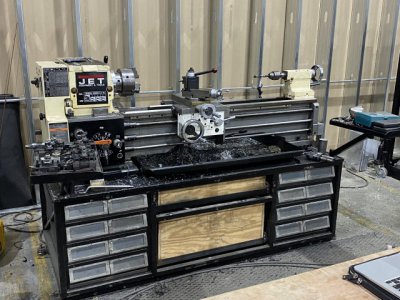
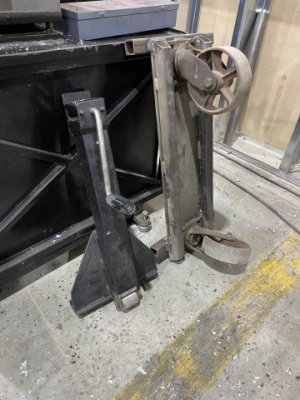
Very rigid X-braced steel frame thats 1" larger than the footprint of the lathe (with the handles removed). I cut down a 30" deep 10 drawer card file for storage. I use a modified trailer tongue jack to lift it high enough for a set of 6" casters and load it into a trailer at the end of every job. I have spindle bearings, MJSK VFD system and the inverter duty motor waiting for installation but my job is really starting to get in the way!


- Joined
- Apr 30, 2012
- Messages
- 1,138


![img_0665[1].jpg img_0665[1].jpg](https://www.hobby-machinist.com/data/attachments/345/345965-ca7ba05ceb5d3dad88fde517033b9082.jpg)
